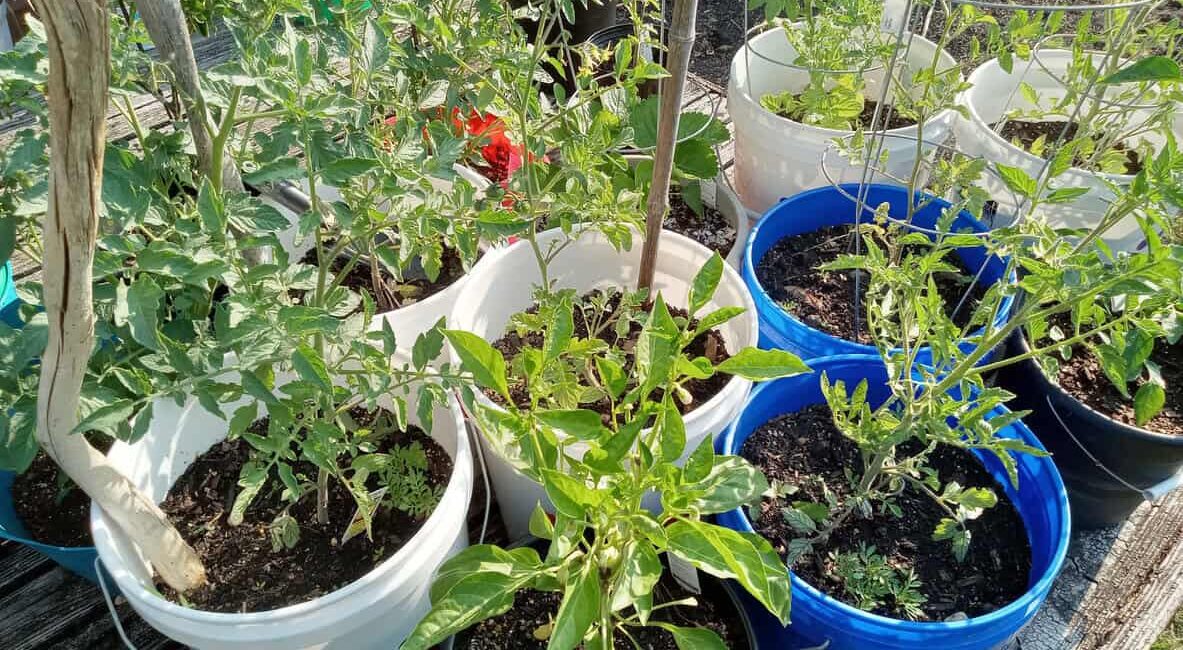Growing your own vegetables has never been more rewarding, especially for those who lack a traditional garden space or live in urban environments. If you’re looking to get started this April, one of the best ways to grow fresh, homegrown produce is by using 5-gallon buckets. These buckets are inexpensive, versatile, and easy to work with, making them perfect for a variety of vegetables. Plus, they can be moved around to take advantage of the best sunlight, ensuring your plants thrive.
This comprehensive guide will take you through some of the best vegetables to grow in 5-gallon buckets, with detailed tips and instructions to help you achieve a healthy and bountiful harvest. Let’s dive into these easy-to-grow veggies that will flourish this spring!
1. Tomatoes 🍅 – Just Add a Cage for Support!
Why Grow Tomatoes in Buckets?
Tomatoes are one of the most popular vegetables (or technically, fruits) to grow in containers like 5-gallon buckets. They thrive in warm weather and are perfect for spring planting. Growing tomatoes in buckets helps keep them off the ground, reduces the risk of pests, and allows you to control the soil quality easily.
Steps to Grow Tomatoes in Buckets:
- Choose the Right Variety: For buckets, it’s best to choose compact or determinate tomato varieties, such as ‘Tiny Tim,’ ‘Patio Princess,’ or ‘Bush Early Girl.’ These varieties grow smaller but still produce delicious fruit.
- Prepare the Bucket: Drill several drainage holes in the bottom of the bucket to ensure good water drainage.
- Planting the Tomato Seedlings: Fill the bucket with well-draining potting soil, leaving about 3 inches from the top. Plant your tomato seedling deep, burying part of the stem to encourage strong root development.
- Support with a Cage: As tomatoes grow, they need support. Place a tomato cage around the plant or use stakes to tie the plant as it grows. This will help the plant stay upright and avoid breakage.
- Water and Fertilize: Tomatoes need consistent watering, but make sure not to waterlog the soil. Fertilize with a balanced liquid fertilizer every two weeks.
Additional Tips:
- Place the bucket in a location that gets at least 6-8 hours of sunlight a day.
- Rotate the plant regularly to ensure even sunlight exposure.
- Be mindful of pests such as aphids and caterpillars, which may target tomato plants.
2. Lettuce 🥬 – Loves Cooler Spring Temps
Why Grow Lettuce in Buckets?
Lettuce is one of the easiest vegetables to grow in containers and does exceptionally well in cooler spring weather. Growing lettuce in 5-gallon buckets allows you to harvest fresh greens all season long without worrying about space.
Steps to Grow Lettuce in Buckets:
- Choose a Variety: There are many types of lettuce, from butterhead to romaine to leaf lettuce. For buckets, loose-leaf varieties work best because they don’t require as much space to grow.
- Prepare the Bucket: Add a mixture of high-quality potting soil and compost to the bucket. Lettuce prefers soil that’s rich in organic matter.
- Planting the Seeds: Scatter the seeds evenly on top of the soil and cover lightly with a thin layer of soil. You can also use pre-grown seedlings for a faster harvest.
- Water and Care: Lettuce needs regular water, but be sure not to overwater, as this can cause the roots to rot. Keep the soil evenly moist and water when it starts to feel dry to the touch.
- Harvest: Lettuce is ready to harvest when the leaves are big enough to eat. You can either pick the outer leaves or harvest the entire head depending on the variety.
Additional Tips:
- Lettuce is a cool-season crop, so ensure it’s grown in a place with plenty of indirect sunlight.
- For a continuous harvest, plant new seeds every two weeks.
- Be sure to keep lettuce away from overly hot spots, as it may bolt (go to seed) prematurely.
3. Peppers 🌶️ – Great in Warm, Sunny Spots
Why Grow Peppers in Buckets?
Peppers love warmth, and buckets allow you to easily control the temperature and moisture. Growing peppers in 5-gallon buckets offers the perfect environment for these plants to thrive, especially during the warmer months.
Steps to Grow Peppers in Buckets:
- Choose the Right Variety: Smaller pepper varieties such as ‘Jalapeno,’ ‘Banana Pepper,’ and ‘Bell Peppers’ are ideal for container growing.
- Prepare the Bucket: Make sure the bucket has proper drainage holes. Fill it with well-draining soil, and add a handful of slow-release fertilizer to the soil before planting.
- Planting the Pepper Seedlings: Plant the pepper seedlings slightly deeper than they were in the nursery pot. If growing from seeds, start the seeds indoors before transferring them to buckets once they’re big enough.
- Watering and Fertilizing: Water the plants consistently but avoid over-watering. Peppers require a steady supply of nutrients, so use a high-potassium fertilizer every few weeks.
- Support the Plant: As the peppers grow, they may need a stake or cage to support the plant.
Additional Tips:
- Peppers thrive in full sunlight, so place your buckets in a sunny spot.
- Be patient—peppers may take a while to mature, but the wait is worth it for the spicy, crunchy fruits.
- Consider adding mulch to retain moisture and keep the soil temperature stable.
4. Bush Beans 🫘 – Compact and Super Productive
Why Grow Bush Beans in Buckets?
Bush beans are perfect for container gardening because they are compact and don’t require a lot of space. They produce an abundance of beans quickly, making them an excellent option for gardeners looking for a high-yielding crop in a small space.
Steps to Grow Bush Beans in Buckets:
- Choose a Bush Bean Variety: ‘Blue Lake’ and ‘Provider’ are popular bush bean varieties that do well in containers.
- Prepare the Bucket: Use a 5-gallon bucket with good drainage. Add nutrient-rich soil and mix in compost to boost soil fertility.
- Planting the Seeds: Plant 2-3 beans per bucket, spaced about 2-3 inches apart. Beans can be directly seeded into the bucket, as they germinate quickly.
- Watering: Keep the soil consistently moist but not soggy. Beans need water to grow, but too much can cause root rot.
- Harvesting: Bush beans are typically ready to harvest 50-60 days after planting. Pick them when the pods are plump and the beans inside are fully formed.
Click page 2 to continue




